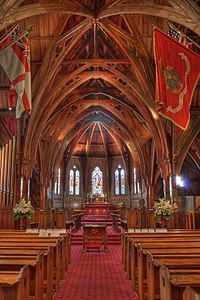Old St Paul's, Wellington
- You may be looking for Old St. Paul's Cathedral, a destroyed cathedral in the City of London; or for Old Saint Paul's, Edinburgh, of the Scottish Episcopal Church.
| Old St Paul's | |
|---|---|
 Main entrance | |
 | |
| Location | Mulgrave Street, Wellington |
| Country | New Zealand |
| Denomination | Anglican |
| Website | Old St Paul's, Wellington |
| History | |
| Dedicated | 6 June 1866 |
| Architecture | |
| Functional status | Consecrated |
| Architect(s) | Reverend Frederick Thatcher |
| Style | Gothic Revival |
| Years built | 1865–66 |
| Administration | |
| Diocese | Heritage New Zealand Pouhere Taonga |
| Designated | 26 November 1981 |
| Reference no. | 38 |
41°16′35″S 174°46′49″E / 41.276262°S 174.780394°E
Old St Paul's is an historic site, a city landmark and a popular wedding and event venue in the heart of Wellington, the capital city of New Zealand. The building served as the pro-cathedral (provisional cathedral) of the Diocese of Wellington of the Anglican Church between 1866 and 1964. It exemplifies 19th-century Gothic Revival architecture adapted to colonial conditions and materials, and stands at 34 Mulgrave Street, Thorndon, close to the parliament precinct.
History

George Selwyn, the first Bishop of New Zealand, purchased part of the site of the church in 1845 and Governor George Grey added to it in 1853,[1] at which time the land stood on a prominent cliff-top overlooking Wellington harbour.[2] Agreement to build the church was reached by 1861[2] and the Reverend Frederick Thatcher, then vicar of St Paul's, Thorndon, was engaged as the architect.
The foundation stone was laid by Governor Grey on 21 August 1865.[3] The building work was executed by John McLaggan and a team of eight carpenters,[4] and the church was consecrated by Bishop Abraham on 6 June 1866.[5]
Soon after the church opened, it became apparent that it was unstable in high winds, and so the south transept, designed by Christian Julius Toxward, was added in 1868.[6] Later additions included the north transept and north-aisle extension, also by Toxward, in 1874; the moving of the chancel five metres to the east and the addition of minor north and south transepts to the design of George Fannin in 1876; the choir vestry in 1882, probably designed by Toxward; and extension of the baptistry as designed by Frederick de Jersey Clere in 1891.[6] Thatcher’s original wooden shingle roof was replaced with corrugated iron in 1895, and subsequently with Welsh slates in 1924.[7]
In 1964 the Diocese of Wellington moved to the new St Paul's Cathedral nearby. After a significant battle to prevent its demolition, Old St Paul's was purchased by the New Zealand Government in 1967, and subsequently restored by the Ministry of Works under the guidance of Peter Sheppard.[8][9]
Architecture
Old St Paul's is built in a Gothic style,[10] albeit with a subdued effect due to the limited resources available. It is constructed from New Zealand native timbers, with stunning stained-glass windows. The interior has been likened to the upturned hull of an Elizabethan galleon, with exposed curving rimu trusses and kauri roof sarking.[10]
Current situation
Old St Paul's is now managed by Heritage New Zealand Pouhere Taonga.[1] While no longer used as a parish church, it remains consecrated, and is a popular venue for weddings, funerals and other services.
The flags displayed in the nave include the ensigns of the Royal Navy, the New Zealand Merchant Navy and the United States Marine Corps (second division), which was stationed in Wellington during World War II.[1] The church retains close links with the New Zealand Defence Force.
Some of the walls and columns of Old St Paul's are decorated with memorial plaques, including many dedicated to those who fought and died in World War I. There is a plaque in memory of Wellington historian John Beaglehole, most famous for his biography of explorer James Cook, but who also played a significant role in the fight to save Old St Paul's from demolition.[11]
Old St Paul's was closed from May 2019 until July 2020 for seismic strengthening work.[12]
References
- ^ a b c History of Old St. Paul's
- ^ a b Sheppard, Peter. Restoring Old St Paul's. Wellington: Ministry of Works, 1970, p. 3.
- ^ Evening Post, 21 Aug 1865, p. 2
- ^ Bircham, Deric. Old St Paul’s: An Illustrated Essay. Wellington: AH & AW Reed, 1981, p. 28.
- ^ Wellington Independent, 7 Jun 1856, p. 5
- ^ a b Sheppard, Peter. Restoring Old St Paul's. Wellington: Ministry of Works, 1970, p. 4.
- ^ Alington, Margaret and Alington, William. Old St Paul’s Wellington: A Pictorial Record. Wellington: Friends of Old St Paul’s Society, 1968, p. 3.
- ^ Cox, Elizabeth (2018). A Friend Indeed: The Saving of Old St Paul's. Wellington. ISBN 9780473397722.
{{cite book}}: CS1 maint: location missing publisher (link) - ^ Kernohan, David. Wellington’s Old Buildings. Wellington: Victoria University Press, 1994, p. 52.
- ^ a b "Old St Paul's". NZ History. Ministry for Culture and Heritage. Retrieved 28 January 2019.
- ^ Beaglehole, Tim. "Beaglehole, John Cawte". Dictionary of New Zealand Biography. Ministry for Culture and Heritage. Retrieved 28 April 2012.
- ^ "Old St Pauls in Wellington to close for seismic upgrade". Stuff (Fairfax). 15 November 2018.
External links
![]() Media related to Old Saint Paul's at Wikimedia Commons
Media related to Old Saint Paul's at Wikimedia Commons
- Anglican cathedrals in New Zealand
- Religious buildings and structures in Wellington City
- Frederick Thatcher church buildings
- Wooden churches in New Zealand
- Gothic Revival architecture in New Zealand
- Carpenter Gothic church buildings
- NZHPT Category I listings in the Wellington Region
- Listed churches in New Zealand
- 1860s architecture in New Zealand
- Churches in Wellington City


